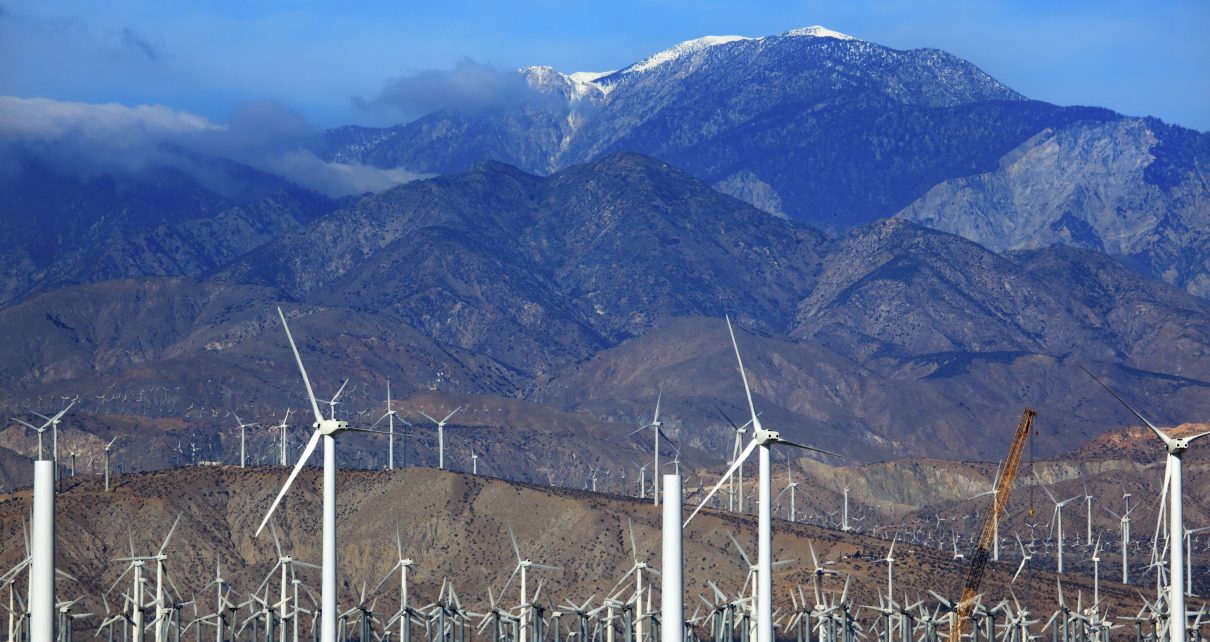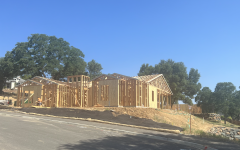
Wind Turbines, Coachella Valley, Palm,Springs, California. (Photo: Bill Perry/Shutterstock)
How Do You Solve a Problem Like CEQA? Part Two
The abuse of CEQA, and the exemptions cop out
By Edward Ring, June 16, 2023 10:00 am
This is the second of a three part series on the impact of the California Environmental Quality Act on development in California and ways to potentially improve the law. It is written in response to hearings conducted over the past three months by the California’s Little Hoover Commission.
One solution to CEQA’s hurdles is to declare exemptions, and California’s state legislature has done this again and again. Sports stadiums. Low income housing. Transportation projects. But what if other projects – vital public infrastructure projects and major private developments – are just as legitimately in need of relief from CEQA and are just as vital to the economic health of California and its people?
At one point the Hoover Commission panelists seemed to agree that instead of revising CEQA, they might just agree on what sorts of project categories should be exempt. This mentality was evident as well in the recent legislative package submitted by Governor Newsom that would have streamlined the CEQA process for vital infrastructure. Killed almost immediately in committee, Newsom’s bills in any case were picking winners. If you want 10 megawatt wind turbines floating off the northern coast, or giant solar farms in the Mojave Desert and South San Joaquin Valley, you would like Newsom’s proposals. If you want more “affordable housing,” where both the needlessly overpriced construction cost and the eventual rental payments by occupants are subsidized by taxpayers, Newsom’s proposals were great policy. Put another way, if you want to burden taxpayers with heavily subsidized, overpriced energy and housing, you may adhere to the prevailing wisdom on CEQA, which is to identify what to exempt from CEQA, favor those project categories, and let everything else continue to wither under an unreformed body of law.
Instead of carving out specific exemptions to CEQA, why not eliminate all exemptions? That might drive all the politically connected special interests back to the table, focusing their minds on what parts of CEQA can stay and what can be scrapped. According to Dan Dunmoyer, president of the California Building Industry Association, back in the 1970s a CEQA report that was only two pages is, today, going to require over 1,000 pages. Dunmoyer said that for a typical 200 home subdivision project the developer can expect to spend at least $1.0 million on CEQA reports in a process that will take 2-3 years, and that’s best case. If there is any litigation, those budgets and timelines go out the window.
One of the most articulate critics of CEQA in the Little Hoover Commission hearings was attorney Jennifer Hernandez, who offered a blistering rebuke of the “infill” mantra that streamlines the process for “tiny homes” and “accessory dwelling units.” Explaining that “welders cannot bike to work and should not have to live in a backyard cottage,” Hernandez suggested that the conversation about CEQA needs to include working people who have practical needs for affordable utility bills, practical transportation infrastructure, and good jobs. She’s right. The impact of CEQA on the price and availability of essentials – housing, water, energy, transportation – imposes direct and often crippling costs on residents. At the same time, California’s politically contrived, uncompetitive prices for land, utilities, and CEQA driven regulatory costs also deters companies from locating in California, or remaining in California, also depriving Californians of job opportunities.
While CEQA debates focus on how to streamline the process to get more renewable energy and subsidized housing, these deliberations ignore the fact that exempting renewables and low income housing actually increases the tax burden on workers who already confront a cost-of-living that is artificially elevated thanks to CEQA. As Hernandez put it, “we are expelling people from California.” Population decline for three years in a row in California, for the first time since statehood was achieved, backs up that statement. It isn’t the weather.
The Use and Abuse of CEQA
Several people addressing the Little Hoover Commission brought up the problem of abuse. Hernandez characterized CEQA as a body of law so complex that uncertainty is inherent and outcomes to litigation cannot be predicted. Lawsuits without merit often win and meritorious lawsuits often lose. Judges will often find just one unforeseeable part of a CEQA report that has fallen short of what they believe is required and send the applicant back to do it all over again. She claimed there is no area of law that has the level of uncertainty of CEQA. She claimed that almost half of California’s production of housing was sued in 2022.
For developers, the almost inevitable arrival of a lawsuit has turned CEQA, as Hernandez described it, into a “litigation defense tool.” The applicant tries to anticipate and answer in advance every conceivable objection to their project, which is, thanks to the complexity of CEQA, an impossible task. Then so-called bounty hunters pounce as soon as the application is filed. Lawyer trolls who identify a crack in the CEQA report and threaten to sue. Settling with these attorneys becomes another cost of doing business.
In CEQA lawsuits today, “significant impact on the environment” has never been defined more broadly. This opens up avenues for litigation that are available not only to environmentalists who may or may not have a legitimate concern about the project’s impact on the environment. It also invites lawsuits from parties with ulterior motives. Labor unions that want the developer to accept a project labor agreement often file CEQA lawsuits, a practice that has come to be referred to as “greenmail.” Business interests that compete with a project developer will often file CEQA lawsuits.
It’s important to recognize how CEQA is abused by special interests with an environmental concern that is indirect at best, but CEQA’s impact is abusive in ways that are explicitly environmentalist. When attorneys representing environmentalist organizations spoke to the Little Hoover Commission panel, their observations reflected what might be characterized as demanding the impossible.
In particular, one environmentalist in their testimony claimed that CEQA prevents housing from being foolishly built if there isn’t any available supply of water for those homes, and that CEQA keeps housing out of fire zones. But it is CEQA that prevents water supply infrastructure from getting built, and it is CEQA that prevents mechanical thinning, controlled burns, and responsible logging in order to prevent dangerous buildup of fuel in forest and chaparral where natural, forest thinning fires have been suppressed for decades.
Some of the environmentalist objections invited immediate rebuttal. One environmentalist explained that “uncontrolled sprawl” cuts into wildlife habitat, harming mountain lions. But only 5 percent of California’s land is urbanized, and California’s mountain lions are thriving. An analysis released by the U.S. Dept. of Agriculture in 2020 estimated that California’s population of mountain lions has grown from less than 600 prior to gaining protected status to over 6,000 today. But this fact is unconvincing for environmentalists who are intent on preserving and increasing mountain lion populations in every subregion of the state.
This preservationist mentality is not limited to mountain lions, of course. Environmentalist lawsuits are filed to stop projects that may threaten the habitat of any species, or subspecies, not only of animals, but also of plants. There is nothing inherently wrong with wanting to save mountain lions, or, for that matter, any species of animal or plant, anywhere. How environmentalists have worked to save the California Condor from extinction is an inspiring story. But the values and priorities of environmentalism must be balanced against the consequences of denying, delaying, and driving up costs for development. And it is ironic, at best, that CEQA exceptions are proliferating for solar and windfarm sprawl, while badly needed housing and vital enabling infrastructure that might consume far less of the “urban/wildland interface” remain under the debilitating scope of CEQA.
- Ringside: Long Term Electricity Storage - July 23, 2025
- Ringside: One Way to Avoid Gasoline Lines in 2026 - July 18, 2025
- Ringside: Is California’s Water Infrastructure Ready for Climate Whiplash? - July 10, 2025








It’s almost always Democrats in the legislature who declare exemptions to CEQA so that their pet projects can be built and so that their cronies can get the contracts. How to solve a problem like CEQA? Get rid of it! However, that will never happen as long as lawless Democrats are a super majority in the legislature?
The biggest and best reform would to require unsuccessful plaintiffs to pay attorney fees and expenses of successful defendants.
Get rid of CEQA. It has nothing to do with preventing any pollution or contamination, and everything to do with funneling money to all of those involved with writing and approving the reports (a revolving-door mess). By the way, I own an environmental consulting company, but we help people stay out of trouble with deal with hazardous and toxic materials.
Must be something stirring in the animal spirits, as more people call out CEQA as a major contributor to CA governmental dysfunction…
From the Pasadena Star News :
https://www.pasadenastarnews.com/2023/06/18/sacramentos-harmful-policies-drive-the-california-exodus/